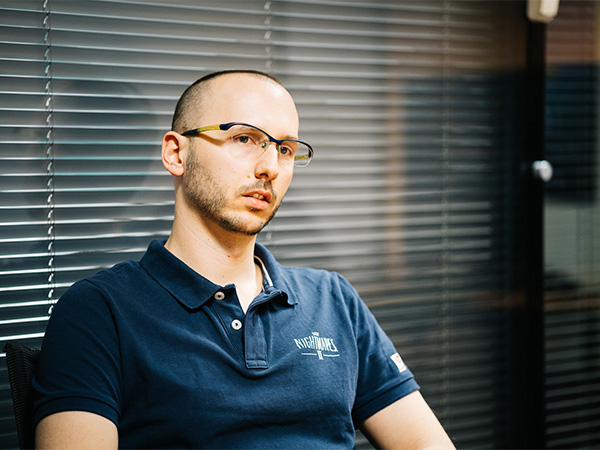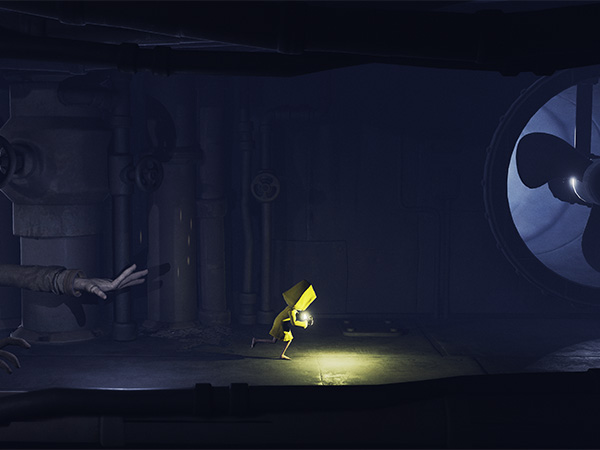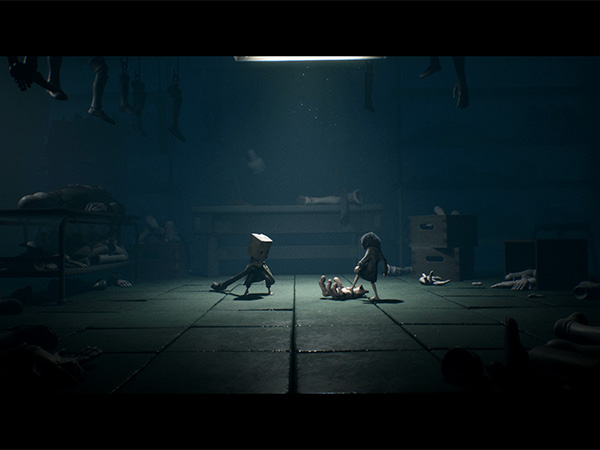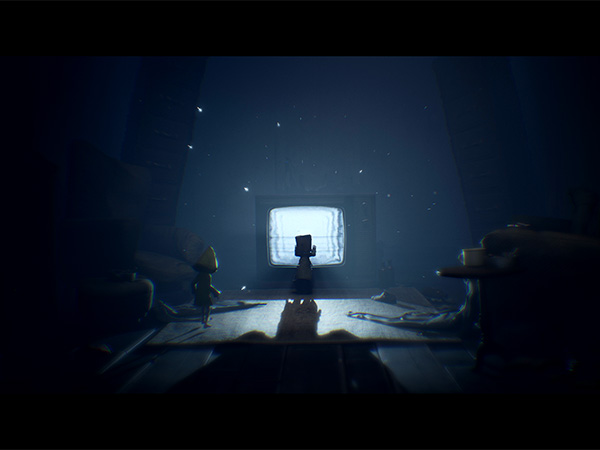We headed to Lyon for part 2 of our in-depth look at the creative minds at BANDAI NAMCO Entertainment Europe (BNEE). We spoke with Lucas Roussel, producer of 2017’s Little Nightmares, as he shed light on the creative process behind launching new titles, his thoughts on the upcoming sequel slated for February 2021, and more.
*This article was originally released in Japan on May 7, 2020.
“Giving players the freedom to create their own stories” – Probing into the dark but adorable world of Little Nightmares

What was the original idea behind 2017’s Little Nightmares?
Lucas: We were first introduced to this new IP in 2015 and we were very excited because we could really see this universe develop into something special. The concept of Little Nightmares is that you play as a child in a very dystopian, very distorted nightmare world. The developers really liked horror and psychological horror, and took a lot of inspiration from books and tv shows. But it’s not a solely horror IP as such, as there is a balance between the “horror” of the world and the monsters that live in it, and the cuteness/innocence of the child-like characters.
A lot of people that play the game might notice that Six, the protagonist, never utters a word. Was this intended to allow players to work out the story, like they’re in a silent movie?
Lucas: That’s a really important point. We thought it was important not to show too much, and wanted players to create the story using their own imaginations. With a silent protagonist, the design takes on a lot of significance in terms of storytelling. So a variety of factors played into our storytelling, such as the character modeling and their animations, and even the behaviors of the monsters when they’re not attacking.

Lucas: Character design was one of those factors. There are two types of characters in the game: children and monsters. The children represent innocence, but players will see it’s not that simple by the end of the story.
In contrast, the monsters represent the bad guys in the real world – people who do nasty things. We depicted them in an exaggerated way where they’re really grotesque, in order to evoke memories of childhood nightmares for players.
For example, in Little Nightmares II there’s a character called the Teacher. She’s an exaggerated version of a sadistic teacher everyone envisioned at one point or another during childhood, and watches the children from unnatural angles with her long neck.

The children and adults in the game represent various elements of real life. Part of the appeal is how it makes you rethink your concept of good and evil, like with how the children aren’t entirely pure beings.
Lucas: Exactly. Remember how the first game ends? We actually came up with the idea for that right at the start. We wanted to pose players questions, and ask them if Six was always like that, or if the environment of the Maw – the mysterious ship where her adventure is set – changed her.
Exploring the relationship between Six and Mono in Little Nightmares II

One really impressive thing about Little Nightmares is the range of actions available in each stage. How did you think up all these mechanics?
Lucas: We wanted every player of our game to re-experience the feeling of being a child. And so we made sure that all the elements that act as mechanics for each level were adult-sized, such as chairs, tables, and door knobs.
An adult could easily reach them, but everything seems too tall or too far away for Six or Mono, since they’re so small. And that means you have to use your imagination to find a solution, to keep moving forward.
The player controls Six in the original game and now Mono in the sequel. But using the first game as an example, we designed it so that when Six climbs somewhere higher up, the player really feels like they’re climbing, too.

Could you tell us about the character design for Six and Mono?
Lucas: The situation is a little different for the first and second games, but in the first one, we wanted to create a contrast between the protagonist Six, and the setting around her and other monsters that appear. We made Six a young girl so that she would show up in stark contrast to the grotesque monsters. She’s also wearing a yellow raincoat, which we chose so that she’d stand out wherever she went in a dark world.

So you wanted a contrast between the character you control, and all the other elements in the first game?
Lucas: That’s right. In Little Nightmares II, we have Mono as our new protagonist and Six from the last game serving as an NPC that follows the player. So the player only controls one character, just like the last game, but there are two characters on-screen going through the levels. We were trying to work out how we could make this new character – Mono – look iconic in a way that stood out from Six’s yellow raincoat, and that was when we came up with the idea for a paper bag over his head.

Could you tell us about the relationship between the two characters?
Lucas: The relationship between Mono and Six is really important to the story of Little Nightmares II. They have a roller-coaster relationship, with a lot of ups and downs. The two are journeying through an incredibly dangerous world, and they’ve got to help each other out if they want to keep going. And that means they both worry about whether they can really trust one another.
Neither of the two characters speak in the sequel, so we tried to answer questions through their actions and let players work it out. That includes questions like how they met, what their relationship is, how they feel about each other, and how they’ll help each other.

It sounds like the sequel is even more richly-detailed and intricate than the first!
Lucas: That’s what we’re aiming for. That’s why the actions and animations for the characters are so important. For example, there are situations in Little Nightmares II where Mono and Six can hold hands to progress through the stage. Seeing small children holding hands in this dark setting makes for a cute and simultaneously emotional scene.
Are there elements in the sequel that were influenced by the response to the original game?
Lucas: With the original, we wanted to create a game that lots of people would play, so it was quite short and affordable. But in terms of post-play reactions, we got a lot of comments saying the story was too short and that they wanted to play for longer. So with Little Nightmares II, we were aiming to create a much larger gaming experience. Rather than just create a sequel, what we’re trying to do is create an entirely new gaming experience.
Was there anything that struck you about the response from Japanese fans in particular?
Lucas: I feel like people in Japan really focused on the cute side of Six as a character, and seemed to really love her.
“We want come up with ideas that haven’t been done before” – The endless possibilities of a new original IP

BNEE’s Little Nightmares has a lot of fans in Japan. What was the experience of creating an all-new original IP like for you?
Lucas: It was a great experience, but of course there were struggles, too. With a new IP, you don’t have any past data to work with, so it’s really hard to predict whether the game you’re creating will get a positive reception in the end. But I had full trust in the team’s creativity, and I really believed in the universe we were creating within the game. I think that helped me overcome the struggles for the first game.
Luckily, Little Nightmares sold well in Europe, America, Asia, and even in Japan the result was good, so we are happy in this regard and we look back at it being a great adventure for us. I’m hoping Little Nightmares II fares just as well and allows us to continue our adventure.

Lastly, do you have any memorable anecdotes of working at BNEE?
Lucas: I was originally involved with a lot of Japanese titles, and started my job at BNEE focused on the European and American markets. That’s why I started out targeting western audiences for Little Nightmares at first, but players were ultimately located all over the world, even in Japan. That was a wonderful surprise.
Little Nightmares combines a lot of distinct elements as a game; I don’t think you could call it a pure horror game, and it’s not violent game, either. You need to use your imagination to progress, but I wouldn’t say it’s only a puzzle game. It’s difficult to classify it into just one genre, which makes it a really unique game, I think.
Creating games with original ideas that haven’t been done before is quite a challenge, so I’m very happy that we were able to come up with something like that for the mass market.
Little Nightmares Official Information
[Official Website] [Twitter]
Editor’s Note
While Lucas was extremely logical in discussing the development of the haunting yet fascinating Little Nightmares, he also had a distinct aura of childlike innocence. Little Nightmares II is due for release in February 2021, and will take players on a new unforgettable adventure that draws on the relationship between Mono and Six.
Jin Sugiyama
Freelance writer & editor. More fond of entertainment than just about anything.




